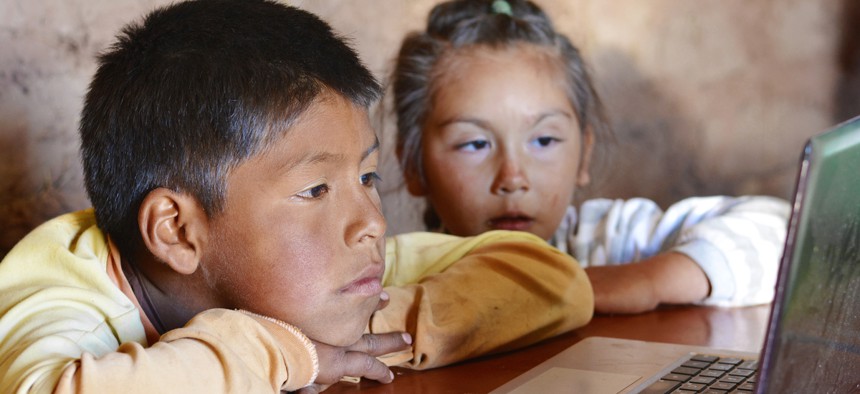The Federal Government Promised Native American Students Computers and Internet. Many Are Still Waiting.

The Bureau of Indian Education has struggled to respond to the COVID-19 pandemic, and some of its schools started the year without enough computers for every student to learn online. Shutterstock
Native American students in BIE operated schools were forced to start the school year without adequate technology, sometimes sharing a single computer among siblings, because the agency disbursed funding late and failed to purchase equipment in time.
Aubrie Sloan expected to start sixth grade in a virtual classroom where she would learn from her teacher each day and engage with classmates for the first time since the coronavirus forced her school to close in March.
Instead, she marks her attendance at Kaibeto Boarding School, on the western side of the Navajo Nation, by texting or calling her teacher each morning. Then she dives into paper packets the school delivers to her home, breezing through assignments that her mother says aren’t a challenge because she already knows the material.
Aside from two phone calls from her teacher, the 11-year-old has received little instruction from the federally-operated school since classes started nearly two weeks ago.
On Sept. 16, the first day of the academic year, Kaibeto administrators sent a letter to parents explaining that the school would not begin online classes until October. And it wouldn’t be able to distribute a computer to every student until November.
“I don’t feel like it’s quality right now,” Katinka Sloan, Aubrie’s mother, said. She added: “I know it’s not just here in Kaibeto. It’s across the board.”
The coronavirus pandemic disrupted education across the country, leaving school districts scrambling for technology to accommodate online learning. The rush caused a national backlog for computers, according to The Associated Press, which in August tallied a combined shortage of 5 million laptops among manufacturers Lenovo, Dell and HP.
Computer shortages have raised nationwide concerns about educational inequities, which are amplified in tribal communities that resisted the Bureau of Indian Education’s desire for in-person instruction in an effort to control rising cases of COVID-19. The inability to attend classes in person, coupled with the bureau’s delay in distributing emergency CARES Act funding, forced some students attending the federally-operated schools to start the new year the same way the last one ended, working on paper packets from home while getting little instruction from their teachers.
At least five BIE-operated schools in Arizona, including Kaibeto, and five in other states were not prepared to start online because the bureau’s late disbursement of federal relief funding delayed purchases for needed laptops and internet hot spots in communities where fewer than half of rural households have access to broadband internet, according to interviews with more than a dozen educators, tribal leaders, parents and lawmakers.
BIE schools lagged behind the rest of the country in providing online instruction after closing this year. About 45% of BIE schools offered digital learning for students, compared with 85% of public schools serving Native students, a nationwide survey conducted in late April by the National Indian Education Association showed. Adding to the challenges, limited cellular service in certain tribal communities hinders the effectiveness of wireless hot spots.
Officials at the BIE and Kaibeto did not respond to multiple requests for comment. But BIE officials previously acknowledged that 95% of students in some of the agency’s schools cannot access the internet at home.
Without the necessary technology and restricted from attending classes in person, Native children who attend BIE-operated schools could fall further behind their peers in traditional public schools, according to education experts.
“If COVID is a real concern, and students can’t get on campus, and there’s no internet access and no computers, then you’re putting families in a situation where they’re just independently home schooling and taking care of their kids,” said Justin Reich, director of the Teaching Systems Lab at MIT, who studies technology’s role in the future of learning. “That’s a terrible tragedy and obviously part of the long history of the American people and the federal government not doing right by Native Americans through these schools.“
The technology delays, which BIE Director Tony Dearman said could in some cases extend into December, offer another example of continued failures by the bureau and its parent agency, the U.S. Department of the Interior. In August, an Arizona Republic and ProPublica investigation found that the BIE and the Interior Department did not correct deficiencies after repeated warnings that the federal government was not providing an adequate education to the more than 46,000 students attending bureau schools.
The BIE, which serves about 8% of Native students across the country, directly operates about a third of the 180 schools and dormitories in its system. The remaining two-thirds are run by tribes or locally elected school boards, which have greater freedom to craft reopening plans and purchase distance-learning equipment.
But tribally controlled schools still had to wait for BIE to release the federal relief funding before purchasing computers and other technology. Lance Witte, the superintendent of Lower Brule Schools in South Dakota, said he postponed the start of school by three weeks because of the funding delay.
“It’s unfortunate, because our kids deserve a lot better,” Witte said.
“In Tears”
Leaders at Kaibeto, a kindergarten through eighth grade school that sits near the Arizona-Utah border, spent the summer crafting plans to start the new year with distance learning.
Like other campuses on the reservation, Kaibeto, where at least two employees tested positive for COVID-19 in the spring, would not physically reopen. The school initially planned to begin with paper packets in August. After BIE delayed the start of classes by six weeks, Kaibeto shifted its plan to online instruction, said Bahozhoi Kinsel-Gishie, president of the school board, which advises administrators but has little day-to-day authority over operations.
The school expected to provide laptops and Wi-Fi hot spots to students. But the laptops never arrived. Kinsel-Gishie recalled that the school’s acting principal, Veronica Klain, told the board during an early September meeting that the laptops hadn’t even been ordered.
“I was in tears,” said Kinsel-Gishie, whose children have been attending online classes at a public school in nearby Page. “I’m thinking, how are we going to be teaching our children? We don’t even have devices. … Our kids are just going to be home doing nothing.”
Staff members combed the school for devices but couldn’t find enough, said Dellard Curley, another board member. So on the first day of class, the school sent a letter to parents saying that students would receive paper packets of homework until October. By then, the school would have distributed at least one device per household.
Siblings would need to share until November, when the school would have sufficient laptops for every student, according to the letter.
“If the decision was left up to us, we would’ve had those laptops in our hands way before this,” Curley said. “Unfortunately, we have our hands tied (by BIE).”
Unlike traditional public schools, which are typically funded by the state and operated at a local level, BIE-operated schools rely on the federal government for money and to order the equipment that would allow them to transition to an online environment.
In March, Congress allocated more than $150 million to the BIE for coronavirus relief in its K-12 schools. The money was supposed to address immediate deficiencies: mental health services for students affected by the pandemic, protective equipment meant to ensure school buildings were safe to reopen and laptops and internet hot spots for distance learning.
In its reopening plan, released in late August, the BIE said its schools would provide distance learning opportunities for all students. Children would receive laptops, Wi-Fi hot spots and solar chargers if they lived in homes with no electricity, according to the plan. Citing supply chain issues caused by the pandemic, the BIE warned that the devices might not arrive by the start of the school year.
The BIE did not begin distributing money to schools until June, according to lawmakers and documents. And once schools received the money, they had to buy the technology through the U.S. Department of the Interior’s system, which requires multiple offices to sign off on a purchase before an order is placed.
“It took BIE 97 days, or three months, to distribute this money, which undermines schools’ ability to prepare teachers, students and employees for the fall,” Rep. Ruben Gallego, an Arizona Democrat who chairs the House Indigenous Peoples Subcommittee, said during a Sept. 10 virtual hearing about BIE’s reopening plans for schools. BIE declined to participate in the hearing because it was not conducted in person.
Federal spending data shows the Interior Department’s Indian Education Acquisition Office, which makes purchases for BIE, signed about 80 orders for IT equipment in response to the pandemic in August and September, more than five months after the CARES Act was signed into law.
A $230,000 order for computer equipment destined for Kaibeto wasn’t signed until Sept. 3. The data does not outline the specific technology purchased, but similar entries for other schools have shown laptops, iPads and other technology.
More than a dozen of the orders placed in August and September were for schools that The Republic and ProPublica identified as not having enough devices when the academic year began.
Tuba City Boarding School, which enrolls about 1,300 students on the Navajo Nation, was among the campuses affected by the delays.
In July, Tuba City sent a survey to parents that asked about the technology they needed to start the school year online. One mother told The Arizona Republic and ProPublica that she needed six computers for her children. By the end of the first week of classes, she had only received two laptops.
Another mother, Audrionna Johnson, told the school she needed a Wi-Fi hot spot. She planned to have her son, Quincey, work on an iPad she already owned, but their home didn’t have internet access. The school, which did not respond to requests for comment, wrote in a letter to parents that students would receive the requested technology during the first week of classes. But no hot spot arrived at Johnson’s home.
Quincey, who has a learning disability, couldn’t log into classes for more than a week. Aside from an introductory call, he had no interaction with his teacher.
“It’s been, what, the second week now? And we haven’t received anything,” Johnson said. Of her son’s academic progress, she said: “It’s like we’re so lost. We don’t know what we’re supposed to do.”
On Friday, 1½ weeks after classes began, Quincey logged into an online class for the first time after receiving a laptop and a hot spot from the school. The class lasted about one hour, Johnson said. She hasn’t heard when he’ll start attending school full time.
Debate Over Physical Classes
Concerns about the delays lay bare a larger debate between the federal government and tribal governments over who should ultimately get to decide the best way to educate children during a pandemic.
As the leader of one of the hardest hit communities in the country, Navajo Nation President Jonathan Nez was one of the strongest opponents to in-person classes in the months leading to the start of school. The Navajo Nation has had more than 10,000 confirmed cases of COVID-19 and over 550 deaths. Months of curfews brought the virus under control, but Nez and other Navajo leaders feared in-person education would risk another outbreak.
In an Aug. 6 letter to tribal leaders, Tara Sweeney, the Interior Department’s assistant secretary for Indian affairs, pushed back the first day of classes for some BIE schools by as much as six weeks. But Sweeney wrote that when classes started, BIE would open the schools under its direct supervision “to the maximum extent possible.”
Nez pushed against any in-person instruction during a call with BIE later that month, insisting that schools on the Navajo Nation spend the first semester online. The tribe’s Board of Education passed a resolution in September to oppose BIE’s plans for in-person instruction.
The federal government relented. On Sept. 17, one day after school started, Sweeney announced that BIE-operated schools on Navajo Nation would only provide distance learning for the first nine weeks of the academic year.
The announcement did not say how schools would operate after those nine weeks.
While Kaibeto awaits computers for all of its students, Curley said he hopes the school can soon begin offering online instruction for students who own computers or who have already received one from the campus.
Aubrie, whose family has a computer and internet access at home, is prepared to start online classes even as many of her classmates continue using paper packets. On Friday, she participated in a 15-minute Zoom session with her teacher, who explained that students would continue to use paper packets until the school transitions online.
Aubrie’s mother, Katinka Sloan, worries that further delays could stifle her education.
During the summer, Sloan considered transferring her daughter to a public school in Page, but chose to keep her at Kaibeto after she was assured that the school would provide online instruction. Now she’s considering transferring Aubrie to an online charter school.
“I gave (Kaibeto) a chance, but it’s not what I want for my daughter,” she said in a text message on Monday.
Alden Woods is a reporter with the Arizona Republic in Phoenix, currently working under a yearlong fellowship with ProPublica's Local Reporting Network.
NEXT STORY: Rising Waters Threaten Great Lakes Communities





